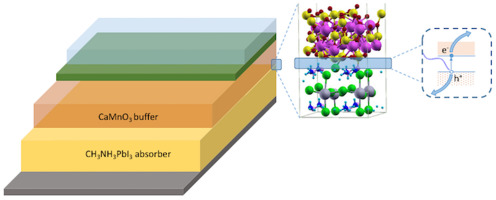Nano Energy ( IF 17.6 ) Pub Date : 2018-01-05 , DOI: 10.1016/j.nanoen.2018.01.009 Kavita Pandey , Deobrat Singh , S.K. Gupta , Pankaj Yadav , Yogesh Sonvane , Igor Lukačević , Manjeet Kumar , Manoj Kumar , Rajeev Ahuja

|
In the present article, the detailed analyses of interface properties and device performance of inorganic perovskite CaMnO3-based buffer layer hybrid perovskite solar cell have been undertaken. Analyses are based on ab initio simulations and macroscopic modelling. A thorough study of electronic and optical properties and interface charge dynamics revealed that CaMnO3 presents a better candidate for the electron transport material in thin film hole transporting material free hybrid perovskite solar cells with the planar architecture than the most common anatase TiO2. This result is founded on the more appropriate band gap and better band alignment with the hybrid perovskite, leading to the faster charge carrier mobility, improved charge transfer and reduced exciton recombination. The results from theoretical simulations are justified by the solar cell model, which explored the basic cell characteristics and parameters: open circuit voltage, short circuit current, fill factor and efficiency, as the functions of cell performance factors, like defect density, diffusion length, absorber layer thickness and band offset. Our model suggests an unoptimized device with a photo-conversion efficiency of almost 10% for the low defect concentrations under 1015. With efficiency in the upper range for HTM free perovskite solar cells, we propose that the CaMnO3-based solar cell poses as an improvement upon the up to now most frequently used ones and provides important step toward their commercialisation.
中文翻译:

使用基于CaMnO 3的缓冲层改善钙钛矿杂化太阳能电池中的电子传输
本文对无机钙钛矿CaMnO 3基缓冲层混合钙钛矿太阳能电池的界面性能和器件性能进行了详细的分析。分析基于从头算模拟和宏观建模。对电子和光学性质以及界面电荷动力学的透彻研究表明,与最常见的锐钛矿型TiO 2相比,CaMnO 3在具有平面结构的无空穴传输材料的复合钙钛矿太阳能电池中是电子传输材料的更好候选者。该结果基于更合适的带隙和杂化钙钛矿的更好带排列,从而导致更快的电荷载流子迁移率,改善的电荷转移和减少的激子复合。太阳能电池模型证明了理论模拟的结果是合理的,该模型探索了电池的基本特性和参数:开路电压,短路电流,填充因子和效率,以及诸如缺陷密度,扩散长度,吸收层的厚度和带偏移。我们的模型建议针对10 15以下的低缺陷浓度使用未优化的器件,其光转换效率几乎为10%。由于对于不含HTM的钙钛矿型太阳能电池具有较高的效率,我们建议使用CaMnO 3基太阳能电池是对目前最常用的太阳能电池的一种改进,并为它们的商业化提供了重要的一步。



























 京公网安备 11010802027423号
京公网安备 11010802027423号